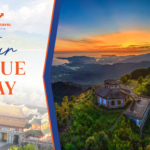
Khai Đinh was the 12 th Emperor of the Nguyễn Dynasty in Vietnam, reigning from 1916 to 1925. His name at birth was Prince Nguyễn Phúc Bửu Đảo. He was the son of Emperor Đồng Khánh.
Khai Dinh Tomb has been declared the most majestic imperial tomb of throughout Vietnam. Being built as a monument and mausoleum, it took to build 11 years, from 1920 year to year 1931, and is the last Hue Imperial tomb in Vietnam.
Emperor Khai Dinh decided to locate his tomb at the foot of the mountain Chau Chu, 9 km south of the city of Hue. In comparison with the rest of imperial tombs, this imperial tomb is small in extent, little more than 5600 square meters ,however its construction, decoration and details are very elaborate.

The structure of the Imperial Khai Dinh tomb is a rectangle of 117 meters long by 48.5 meters wide, resting on the mountain Chau Chu. Khai Dinh tomb is constructed largely of reinforced concrete and the Imperial tomb of Hue has more Western influences due to his education was made in most of in France.
The imperial tomb has two very different parts: the Palace Thien Dinh, where we can see the sarcophagus of Emperor Khai Dinh, and the outside of the Tomb Imperial, where statues of the courtyard of ceremonies, the House of mandarins and Pavilion of steles, hexagonal – shaped, is most remarkable.
Upon crossing the gateway to the imperial Tomb, we find 37 steps whose railings have been carved in the shape of dragons ,these dragons are the largest of all Vietnam.

Once you have uploaded the steps, we will find ourselves with a small courtyard with houses of the mandarins on both sides. To access the next part of the Hue Imperial Khai Dinh Tomb, we will have to climb other 29 steps, this is one of the most beautiful points of the visit, the courtyard of ceremonies, with stone statues (rare material in this imperial tomb), which unlike the rest of Hue imperial tombs, has 2 rows of statues where the second row are the bodyguards of the Emperor.
In that same place of the Tomb in the courtyard of ceremonies, we have the stele Pavilion, with a stele engraved in stone on the life and reign of the Emperor. This monument is unique, as is the single flag of the stele of all Hue imperial tombs whose shape is hexagonal.

The last part of the complex Khai Dinh, to the top of the Imperial Tomb, is the Thien Dinh Palace, where we can see the sarcophagus of Emperor. This Palace of the imperial tomb is formed by several ranches communicated among themselves where the main hall contains a statue of the seated Emperor Khai Dinh upon his throne and at his feet, his sarcophagus. The decoration is made with stained glass and mosaics built ceramic based broken into pieces.
Khai Dinh was educated most of in France so his tomb architecture is influenced by European architecture. It has perfect combination of Western and Eastern architecture and combination of oversea modern material and to traditional domestic crafts

The Imperial tomb of Khai Dinh is so elaborate and with so many details, King Khai Dinh had to go to French to find out and purchase buy steel, iron, cement and tiles. The Emperor also sent ships to China and Japan to purchase ceramics and stained glass needed for the Tomb.

It is worthy to spend your time to visit the tomb with unique artwork, reaching to this tomb, you will be in splendid palace that took 11 years to build by skillful crafters and especially the materials were shipped from France and Japan.
READ MORE: MINH MANG TOMB












